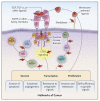Personalized oncology in interventional radiology
- PMID: 23885909
- PMCID: PMC3742380
- DOI: 10.1016/j.jvir.2013.04.019
Personalized oncology in interventional radiology
Abstract
As personalized medicine becomes more applicable to oncologic practice, image-guided biopsies will be integral for enabling predictive and pharmacodynamic molecular pathology. Interventional radiology has a key role in defining patient-specific management. Advances in diagnostic techniques, genomics, and proteomics enable a window into subcellular mechanisms driving hyperproliferation, metastatic capabilities, and tumor angiogenesis. A new era of personalized medicine has evolved whereby clinical decisions are adjusted according to a patient's molecular profile. Several mutations and key markers already have been introduced into standard oncologic practice. A broader understanding of personalized oncology will help interventionalists play a greater role in therapy selection and discovery.
Keywords: ALK; ATP; BCR-ABL; BRAF; CD-20; CML; CRC; EGFR; EML4; FDA; Food and Drug Administration; HCC; HER-2; KRAS; Kirsten rat sarcoma viral oncogene; NSCLC; PDGFR; SMKI; VEGF; VEGFR2; adenosine triphosphate; analplastic lymphoma factor; breakpoint cluster region/the Abelson tyrosine; c-KIT; chronic myelogenous leukemia; clusters of differentiation-20 (antigen of B-cells); colorectal carcinoma; echinoderm microtubule-associated protein-like 4; epidermal growth factor receptor; hepatocellular carcinoma; human epidermal growth factor receptor-2; mAb; mTOR; mammalian target of rapamycin; monoclonal antibody; non–small cell lung carcinoma; platelet-derived growth factor receptor; small molecule kinase inhibitor; tyrosine-protein kinase kit or mast/stem cell growth factor receptor; v-raf murine sarcoma viral oncogene; vascular endothelial growth factor; vascular endothelial growth factor receptor-2.
Copyright © 2013 SIR. Published by Elsevier Inc. All rights reserved.
Figures




References
-
- Li J, Chen F, Cona MM, et al. A review on various targeted anticancer therapies. Target Oncol. 2012;7:69–85. - PubMed
-
- Kalia M. Personalized oncology: recent advances and future challenges. Metabolism. 2013;62(suppl 1):S11–S14. - PubMed
-
- Gasparini G, Longo R. The paradigm of personalized therapy in oncology. Expert Opin Ther Targets. 2012;16(suppl 1):S7–S16. - PubMed
-
- Cronin M, Ross JS. Comprehensive next-generation cancer genome sequencing in the era of targeted therapy and personalized oncology. Biomark Med. 2011;5:293–305. - PubMed
Publication types
MeSH terms
Substances
Grants and funding
LinkOut - more resources
Full Text Sources
Other Literature Sources
Research Materials
Miscellaneous

